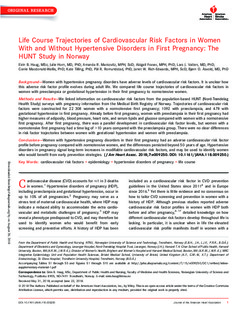| dc.contributor.author | Haug, Eirin | |
| dc.contributor.author | Horn, Julie | |
| dc.contributor.author | Markovitz, Amanda Rose | |
| dc.contributor.author | Fraser, Abigail | |
| dc.contributor.author | Vatten, Lars Johan | |
| dc.contributor.author | Macdonald-Wallis, Corrie | |
| dc.contributor.author | Tilling, Kate | |
| dc.contributor.author | Romundstad, Pål Richard | |
| dc.contributor.author | Rich-Edwards, Janet Wilson | |
| dc.contributor.author | Åsvold, Bjørn Olav | |
| dc.date.accessioned | 2018-08-28T07:23:10Z | |
| dc.date.available | 2018-08-28T07:23:10Z | |
| dc.date.created | 2018-08-26T16:08:10Z | |
| dc.date.issued | 2018 | |
| dc.identifier.issn | 2047-9980 | |
| dc.identifier.uri | http://hdl.handle.net/11250/2559500 | |
| dc.description.abstract | Background: Women with hypertensive pregnancy disorders have adverse levels of cardiovascular risk factors. It is unclear how this adverse risk factor profile evolves during adult life. We compared life course trajectories of cardiovascular risk factors in women with preeclampsia or gestational hypertension in their first pregnancy to normotensive women. Methods and Results: We linked information on cardiovascular risk factors from the population‐based HUNT (Nord‐Trøndelag Health Study) surveys with pregnancy information from the Medical Birth Registry of Norway. Trajectories of cardiovascular risk factors were constructed for 22 308 women with a normotensive first pregnancy; 1092 with preeclampsia, and 478 with gestational hypertension in first pregnancy. Already before first pregnancy, women with preeclampsia in their first pregnancy had higher measures of adiposity, blood pressure, heart rate, and serum lipids and glucose compared with women with a normotensive first pregnancy. After first pregnancy, there was a parallel development in cardiovascular risk factor levels, but women with a normotensive first pregnancy had a time lag of >10 years compared with the preeclampsia group. There were no clear differences in risk factor trajectories between women with gestational hypertension and women with preeclampsia. Conclusions: Women with hypertensive pregnancy disorders in their first pregnancy had an adverse cardiovascular risk factor profile before pregnancy compared with normotensive women, and the differences persisted beyond 50 years of age. Hypertensive disorders in pregnancy signal long‐term increases in modifiable cardiovascular risk factors, and may be used to identify women who would benefit from early prevention strategies. | nb_NO |
| dc.language.iso | eng | nb_NO |
| dc.publisher | Wiley Open Access | nb_NO |
| dc.relation.uri | https://www.ahajournals.org/doi/10.1161/JAHA.118.009250 | |
| dc.rights | Navngivelse 4.0 Internasjonal | * |
| dc.rights.uri | http://creativecommons.org/licenses/by/4.0/deed.no | * |
| dc.title | Life Course Trajectories of Cardiovascular Risk Factors in Women With and Without Hypertensive Disorders in First Pregnancy: The HUNT Study in Norway | nb_NO |
| dc.type | Journal article | nb_NO |
| dc.type | Peer reviewed | nb_NO |
| dc.description.version | publishedVersion | nb_NO |
| dc.source.volume | 7 | nb_NO |
| dc.source.journal | Journal of the American Heart Association | nb_NO |
| dc.identifier.doi | 10.1161/JAHA.118.009250 | |
| dc.identifier.cristin | 1604536 | |
| dc.description.localcode | (C) 2018 The Authors. Published on behalf of the American Heart Association, Inc., by Wiley. This is an open access article under the terms of the Creative Commons Attribution License, which permits use, distribution and reproduction in any medium, provided the original work is properly cited. | nb_NO |
| cristin.unitcode | 194,65,20,0 | |
| cristin.unitcode | 194,65,20,15 | |
| cristin.unitname | Institutt for samfunnsmedisin og sykepleie | |
| cristin.unitname | Helseundersøkelsen i Nord-Trøndelag | |
| cristin.ispublished | true | |
| cristin.fulltext | original | |
| cristin.qualitycode | 1 | |

